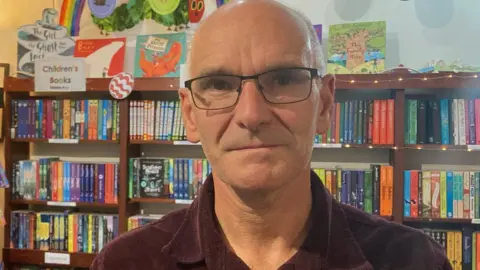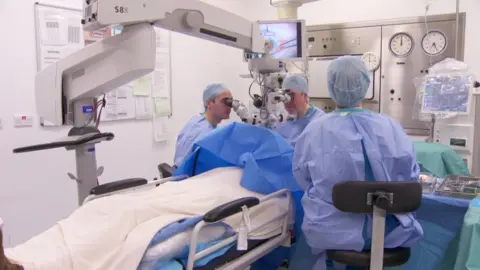 BBC
BBCA bookstore owner who has undergone corneal transplants four times says it has not only changed his eyesight but also his life.
David Torrance was diagnosed with keratoconus when he was a teenager. Keratoconus is a disease in which the cornea weakens, becomes thinner, and changes shape.
Eventually, the eye's ability to focus properly is impaired.
A consultant eye surgeon from Belfast said patients were having to wait longer for transplants because of the lack of corneas available.
Public Health Agency (PHA) figures show that only a third of the number of corneas needed for transplant in Northern Ireland in 2022 were donated by people in Northern Ireland.
Dimple Patel, a specialist in corneal diseases, said there was a need to dispel the myths and discomfort surrounding organ donation.
The cornea is the transparent outer layer on the front of the eyeball that allows light to enter the eye so you can see.
“The transplant gave me hope.”
In David's case, his vision became “blurry” and life became “difficult at times.”
“We're talking about not being able to see much in front of you, both in terms of distance and in terms of reading,” he said.
“Reading, driving, playing sports, etc. were not possible for quite some time. It was something I got used to, but it made it difficult for me to lead a normal life.
“I was very lucky because one eye was always worse than the other.
“Where the difficulties could arise was when both eyes started to deteriorate,” he said.
Keratoconus affects between 1 in 3,000 and 1 in 10,000 people and can cause vision loss and the need for a corneal transplant.
The exact cause of this condition is unknown.
This is one of the most common reasons for corneal transplantation in young patients.
Around the age of 16, David noticed that his eyesight was deteriorating.
A corneal transplant was the only way to improve his vision, and he was placed on the transplant list.
“You're upset, but you're dealing with it,” he said.
“The fact that there is a solution and that I can do something to cure it or help it or make it right filled me with hope.”

The owner of No Alibis Bookstore received his first corneal transplant in his left eye in 1984.
He had three more transplants, two more in his left eye and one in his right eye, and each time his vision changed, which he said was “amazing.”
“I'm in the bookstore talking about books, reading books, being surrounded by books and doing what I love,” he told BBC News NI.
“There was a time when it was very frustrating to be here, just because I couldn't choose this. [book] Wake up and look at it. I can't read it. Everything is fine now,” he said.
“A chance to see clearly again.”
David said the gift of donating a cornea or an organ is “transformative and extremely important” and he would encourage people not to feel uncomfortable about it.
“The initial reluctance and hesitation to donate corneas is understandable, because corneas are the only organs in the body that we can donate that we can actually visualize and see.
“People can get very emotional and emotional about it,” he said.
“Giving someone the chance to see clearly again and be able to visualize what's around them is as life-changing as any other organ donation,” he said.
According to NHS Blood and Transplant (NHSBT), the cornea is the most common organ or tissue that people choose not to donate.
When registering their donation decision, 81% of people choose to donate all their organs and tissues.
Approximately 19% chose to specify/restrict the organs or tissues that could be used. Of these, 63% choose not to donate their corneas.
This corresponds to 11.5% of all donor registrations being restricted to the eyes.
Dimple Patel said corneal transplants were one of the most commonly performed transplants in the UK and around the world, and were carried out every week at the Belfast Trust.

Ms Patel said their biggest problem was the availability of corneal tissue.
“We are a net importer, not a net exporter. We receive more corneas as donations from people in Northern Ireland than we send to eye banks.”
He said there was a fear factor when it came to cornea donation, which was one of the biggest reasons for Northern Ireland's low donation rate.
“Patients are willing to donate many parts of their body, but the eye is one part of their body that they are very reluctant or unwilling to donate.
“Each eye can benefit up to nine recipient patients, meaning not only the cornea but also the white wall of the eye is useful to the patient and has research benefits as well,” Patel said. said.
Once the cornea is donated, the eyeball is harvested and sent to the NHSBT Eye Bank in the UK.
The eyes will be checked for disease or infection before being sent for donation.
Ms Patel said the longest waiting period she has regularly been on the list for is just over a year.
However, she said patients should not wait longer than six months for a corneal transplant, as waiting too long for a corneal transplant will also affect the success and outcome of the transplant.



